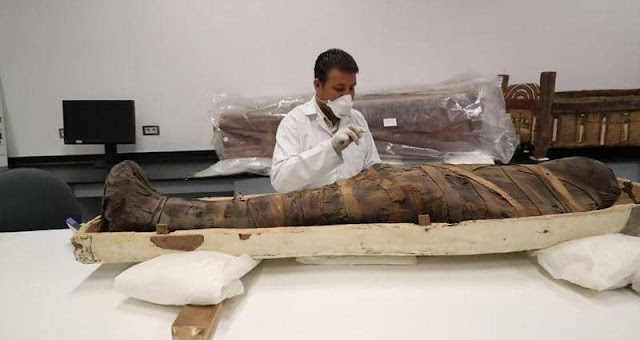
Video of an Egyptian mummy speaking 3 thousand years after her mummification

Egyptian mummy examination image
The researchers said that the "voice" of Nissiamon, who lived during the reign of Pharaoh Ramses XI, had been heard for the first time since his death and mummification 3,000 years ago.
The mummy of Nessiamon was the subject of great scrutiny. The linen fabrics that were covered were dismantled, and the mummy was exposed in the year 1824, according to the British newspaper, The Guardian.
After various tests and examinations, it became clear that the priest Nissiamon was in his fifties when he died, and he may have died of asphyxia, due to an allergic reaction caused by an insect sting in his tongue.
The reason for this belief, according to one expert, is because his tongue sticked out of his mouth without any damage to the bones around his mouth and neck.
Although Nissiamon's death was unfortunate, he was fortunate after that, as his mummy was moved shortly before a German air raid on Leeds in 1941 that destroyed the museum and its many traces.
Recently, a team of researchers printed a three-dimensional copy of the sound course of the priest Nissiamon, to hear his voice.
"What we did was produce Nessiamon's voice," said Head of Electronic Engineering at Royal Holloway College, University of London and co-author of the study, but he explained that "it is not a voice of his words, he is not actually speaking."
The team wrote in the "Scientific Reports" magazine that they transported the mummy to Leeds General Hospital, conducted a series of CT scans, and the team was able to produce a digital reconstruction of the Nissiamon's sound stream, and remodel it in 3D printing.
The process of reproducing the mummy's sound was not easy, as embalming and burial for a long time had a great impact, as the tongue was refined and the soft palate lost, with the team having to fill it, then they attached their model to an electronic larynx and amplifier.
The sound stream purifies the sound produced by the air that passes through the throat, which results in a unique sound for each person, and therefore the position of the various components of the sound stream can produce certain words or other singes (sounds).
"The voice of our throat is electronic," The Guardian quoted Howard as saying, "If this sound was made by Nissiamon, he would pass the lung air out through his throat as the vocal cords vibrate to create the same effect."
If the insect bite theory of the priest's tongue is correct, then the last words of Nisyamon might have been expected to be “oh” or “brother” or “any” or the like, but the team found that the last sound sounded like “ewgog”.
According to Howard, the dimensions of Nissiamon's throat and vocal pathways indicate that his pitch is slightly higher than the average man's voice today.
The team stated that Nissiamon's voice had a decisive role in his work, as he had to speak, chant or sing as part of his role as a priest and incense-holder and perfume writer at Karnak Temple in Thebes.
According to the archaeologist and co-author of the study at York University, Professor John Schofield, the team's style can offer the public a new way to deal with the past, adding, "It gives intense excitement and the additional dimension that this can bring to museum visits."
He continued, "The idea of going to the museum and going out after hearing a sound 3,000 years ago is the kind of thing that people may remember for a long time. What we would like to try to do next is to develop a computer model that allows us to move the sound stream and form different sounds, and we hope that Words will be clear at the end. "
For her part, Salima Ikram, a professor of Egyptology at the American University in Cairo, said that the study is "surprisingly wonderful." ".
